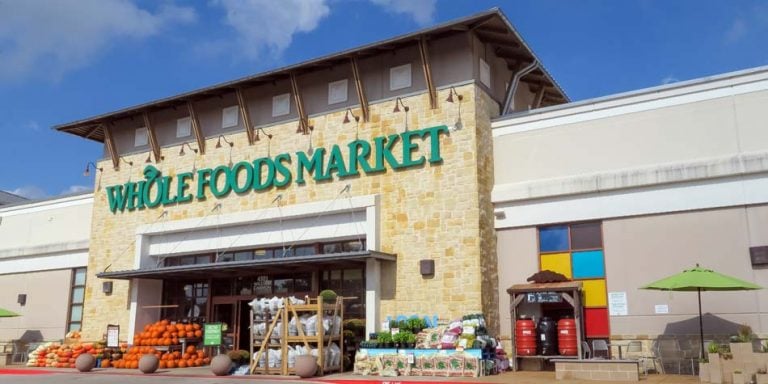Happy (almost) birthday to the pairing of Amazon.com, Inc. (NASDAQ:AMZN) and Whole Foods Market. Though the deal wasn’t officially consummated until late August of last year and had been rumored for a while beforehand, Amazon’s Whole Foods acquisition was officially offered in June of 2017. Effectively, the $13.7 billion buyout took shape then.
It was a team-up that invited much speculation. Observers on both sides of the table — and even more observers who didn’t have a seat at the table — knew the pairing could prove disruptive to the likes of Walmart Inc (NYSE:WMT) and Kroger Co (NYSE:KR). But it wasn’t exactly clear what Jeff Bezos had in mind as a means of revitalizing the struggling grocer. Investors just figured the buyer would electrify the buyee, much like Amazon electrifies everything else it touches.
If we’re being honest though, it’s not clear the deal has proven especially fiscally beneficial for either outfit.
Amazon’s Whole Foods Changes Uninspired
Don’t misread the message. Regular patrons of Whole Foods stores have seen changes. Chief among them is lower prices on some key items — price cuts that went into effect the same day the acquisition was completed. Members of Amazon Prime, which offers free two-day shipping on most items ordered via Amazon.com to customers willing to pay the $99 per year fee, enjoyed even bigger and better discounts.
The e-commerce giant also rolled out pre-packaged meal kits in conjunction with Amazon’s Whole Foods acquisition. This confirmed suspicions it wanted to leverage Whole Foods’ stores not only as a sales venue for its own products, but also Whole Foods’ supply chain. These meal kits were already being sold to customers of Amazon Fresh, Amazon’s online grocery store. But Whole Foods’ customers were an even better target market for meal kits. These customers are slightly younger and more affluent than the average grocery store’s clientele. They’re the same crowd that’s more likely to embrace online shopping and subscriptions to services.
Indeed, Amazon.com even used some of the grocery stores’ square footage during the holiday shopping season to erect “pop up” shops that offered Amazon’s home-grown electronics, while “flash sale” delivery vans have occasionally been seen parked out front of Whole Foods stores to pass along non-food goods purchased online.
None of it was truly unexpected.
Still, Amazon’s Whole Foods acquisition has yet to yield that proverbial “killer app” that many were expecting to materialize by this point.
A Bigger Web Isn’t Always Better
To be fair, it’s possible and even likely that Amazon.com has benefited in ways that aren’t easy to see. As was noted a little less than a year ago, Amazon now has access to the grocery-shopping habits of millions of consumers. These customers may not have been part of its ecosystem before Amazon’s Whole Foods deal was completed. In the modern era of marketing, digital data is marketing firepower.
Positioning itself as a full-blown grocer — which Amazon Fresh never quite fully did — also made last October’s news a little less creepy and a little more credible. The company’s then-new service would allow willing customers to authorize Amazon’s delivery drivers to enter a home without the owner being present, and when applicable, leave food items in the refrigerator.
All these changes and improvements, no matter how small or seemingly insignificant, have been part of a much bigger effort to bring new customers into the circle, and bring existing customers deeper into the circle. Once on board, Amazon.com can find a myriad of other ways to monetize those consumers.
Amazon Prime memberships, which offer additional discounts to Whole Foods shoppers, is one such example. Once a customer has access to free shipping options, they’re much more likely to shop at Amazon.com.
It’s just not clear, however, if the benefits have outweighed the costs.
Perhaps it’s just a matter of more time, and more tinkering. Or, perhaps no amount of time will really help this unlikely alliance find some meaningful synergies.
Bottom Line on Amazon’s Whole Foods Buyout
To the extent any letter grade can be given to a moving target like Amazon, the handling of its purchase of Whole Foods has to be given a “C” simply because it’s not clear if there’s been an actual net benefit; changes have been modest.
Certainly more consumers are becoming Prime members, with some of them likely only signing on because they’re Whole Foods fans. The fact that Amazon upped the price on an annual Prime membership from $99 per year to $119 per year, though, may tacitly point to the idea that all these perks are costing the company more than they’re worth to the company. Worse, nearly half of pre-price-hike Prime customers said they would cancel their membership at the higher price.
Many of them may simply be grumbling rather than planning on leaving the program. Even so, when half of an entire group of customers are talking the talk, enough of them are apt to walk the walk. If a value-perception problem hasn’t taken shape yet, it soon will.
Fanning those flames of concern are the fact that Whole Foods’ initial price cuts have at least been partially unwound, and annoyingly empty shelves with Amazon in charge have been too common.
Sure, Amazon picked up some Prime members that it may not otherwise have, but it was adding Prime members at breakneck speed anyway. It didn’t need Whole Foods to do that.
Bottom line? After $13.7 billion was plunked down, investors and/or consumers would have expected at least something a little more dramatic than the modest changes we’ve seen — even if the overarching goal was just more customer data. Hopefully those changes are still in the works, because we sure haven’t seen much in the way of change yet.
As of this writing, James Brumley did not hold a position in any of the aforementioned securities. You can follow him on Twitter, at @jbrumley.

